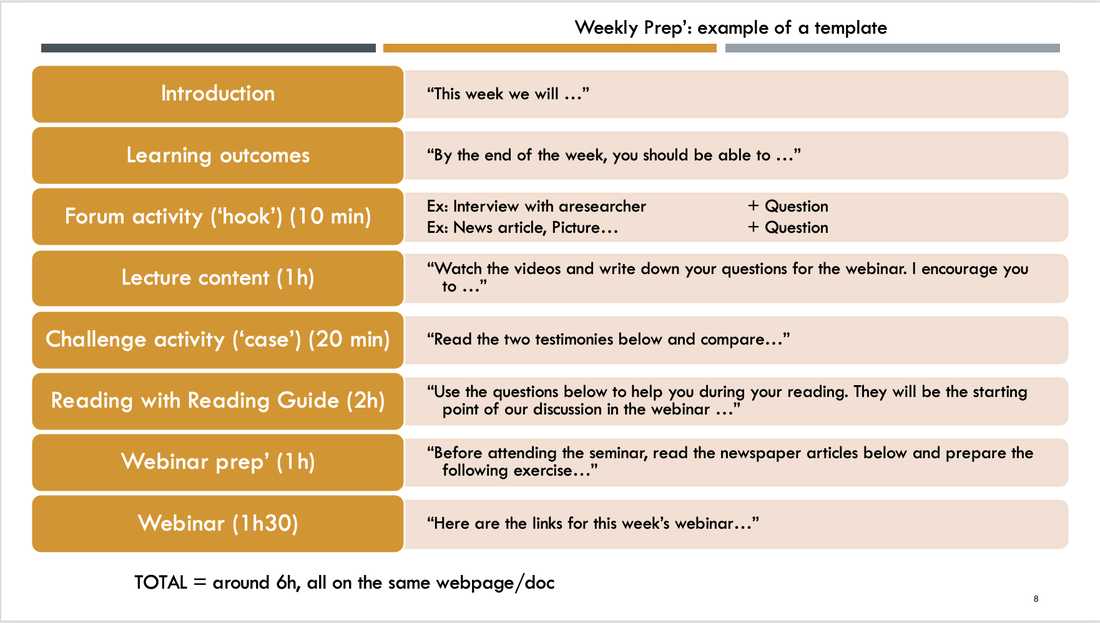|
Shifting to online teaching can be stressful, as it is full of unknowns. Identifying right on what the key challenges of online teaching are and addressing them as soon as possible is a good way towards making this experience as fulfilling as possible (and the least stressful and time-consuming down the line). In this blog post, I share with you some tips I learnt (the hard way) when I was a lecturer at Queen Mary University of London and in charge of developing modules for their online Master's in International Relations. Colleagues and friends have asked me to give them some insights into what was coming ahead. I tried to do so without sugarcoating - but also without losing track of the optimistic solution-oriented mindset that we so much need right now. In this blog post, I share with you the advice that I shared with them. Challenge No 1: Difficulty to maintain students' engagement Maintaining students' engagement is a well-known challenge of online teaching. This challenge can manifest in different ways. Students may not use the asynchronous activities we provide to them. They may use them but 'passively' (e.g. they'll listen to your lecture as a shower time podcast). They may not speak up in webinars etc. Best case scenario: the lack of engagement runs the risk of an online teaching environment that lacks dynamism for teachers and students. Worst case scenario: the lack of engagement leads to the permanent drop out of some students or some very bad surprise when comes the evaluation, if students/teachers don’t realise soon enough that the lack of engagement has resulted in students being out of track in regards to the module's learning curve. Challenge No 2: Risk of hyper-individualised teaching The second challenge arises from the difficulty of creating a sense of learning community within the class or more generally the cohort. In such absence, the risk of hyper-individualised teaching increases, by which I mean that some students may experience direct interactions with their teachers as their only learning resources. This situation has several negative consequences. Students don't learn from each other (and therefore tend to perceive their struggles as personal issues rather than collective pedagogical challenges). Students feel isolated (which decreases their overall learning experience). Students don’t invest in the full range of teaching activities available to them (which may lead them to miss critical content and information). Instead of learning how to learn autonomously (an essential skill for life-long learning and self-assessment), they become dependent on the teacher. Finally, this increases the pressure on teachers who are more likely to become overworked. Challenge No 3: Lack of informal socialisation on campus/between students In the ‘global classroom’ of internationalised higher education, students have very diverse backgrounds. When on-campus education happens, students learn at a fast pace upon their arrival the foundational knowledge and skills that will determine their overall academic performance for the rest of the year. In my experience of on-campus teaching at LSE (the university with the highest percentage of foreign students at a British university), I see that the first couple of months are crucial for students to learn :
That being said, what we see is that: - These Challenges are not specific to online teaching. Yet, the chances that they end up causing you trouble increases because of online teaching. And their consequences are more difficult to address because of online teaching - Because these challenges are not specific to online teaching (spoiler: this is a silver lining) developing tools and practices to address such challenges in online teaching… will help you to improve your on-campus teaching! How to address these challenges?Here the objective is for you to find the perfect ratio that - minimises the time and effort you spend adapting your on-campus curricula to online teaching and - optimises the quality of the online teaching experience for you and your students. Based on my experience, I suggest you to: Make some shifts in regard to:
What do I mean by this? Rethink your relation to students - The 'pedagogical experience' I encourage you to rethink how you relate to students by getting rid of the on-campus managerial workload idea of 'contact time' (e.g. "For this module, my workload is 1.5h lectures and 1.5h seminars per week"). Instead, I encourage you to adopt a mindset more adapted to online teaching: think about what you are doing in terms of 'providing a pedagogical experience'. By this, I mean providing an experience: 1. Structured in an online space: whatever platform your university uses, make sure it becomes your pedagogical online environment, a space that reflects your teaching personality and in which you can link more than the pedagogical content that you personally create. 2. Structured in time: I encourage you to adopt a weekly format as it sets a good rhythm (both flexible and dynamic) for you and your students. By this I mean that the week becomes the new pedagogical unit around which you develop your curricula (rather than the lecture+seminar duet for those who use this format). Accordingly, you can provide students with a weekly document that summarises all the activities you want them to do during this week (I say document but depending on the platform you use, it might be better to have it summarised on a dedicated webpage). I call this document 'Weekly Prep''. In the image below, I synthesise the structure of what this document typically looks like for me. On the left side, you see the titles of the sections of the document. On the right side, I detail what the activities consist of and how I would introduce/formulate them for the students. As you can see in the template, I encourage you to time all the activities. The weekly document summarises all the activities you want the students to do this specific week timed up to the amount of time you expect them to spend per week on this module for them to be able to get the most of out it. Timing activities provides students with a handrail that helps them estimate the amount of preparation expected on their part. It also helps establish an informal understanding between you and the students that online learning is far from passive. Also, be regular about when you add core elements on your online platform, as regularity (e.g. making a lecture recording available every Monday) helps create rhythm and structure throughout the term. 3. With standardised activities and format: Standardise how your activities look like and how you call them. You don’t want students to think that you dump things on them! The feeling you want to generate is that everything that you provide is part of a pedagogical project you have carefully designed for them to have the best learning curve conditional on their personal input. Rethink your relation to students - How you communicate Take some time to think strategically about how to organise your communication with students in a way that is clear for them, makes you feel in control, and aligns with your values. Keep in mind that every issue you have encountered in the past with this module runs the risk of being amplified when you teach online. In very practical terms, what I recommend you to do is to:
- Make explicit your role and their role, and what you expect from them. For example, some students might have never been in a university system with office hours. Guide them by giving them clues about what the practices you ask them to engage with entail (for example, what they should do before an office hour appointment: "Before attending your appointment, please revise the lecture material and think about the questions you may want to ask your teacher during the appointment"). - Think about the communication channels that fit you better (e.g. email only for personal reasons, one admin forum + one pedagogical forum on your module's platform); be explicit about how students should use them; be strict in enforcing your instructions until they are adopted.  pixabay.com pixabay.com As you can see, these steps not only help you transition to online teaching but also represent long-term investments whose rewards you will reap when you will return to campus. - It is good practice to revise/update our syllabus every now and then... now is the time! - I have kept the habit of using the Weekly Prep' document for face-to-face teaching and students often comment on how well structured my modules are! Rethink your content In the Weekly Prep template above, you can see that I refer to "hook" and "cases". These are some activities that I used in order to turn my on-campus lectures into more interactive online pedagogical experiences (and that I kept using when I reverted to on-campus teaching!). Here are some ideas to help you make your content more interactive:
Rethink your role At the risk of sounding simplistic, I will try to be as direct as possible. I encourage you to shift your mindset from being someone whose job is to produce and deliver content, and embrace becoming all of the below: I hope this blog post can be of help for some of you. Don't forget that you're the best and best of lucks for the crazy year to come. PS/Disclaimer(s): I wrote this blog on my own personal capacity and the information contained in it may not represent the official pedagogical line of my previous and current employers. Also, I don’t know Eric Carle and I haven’t read his book but this dolphin cover is amazing.
1 Comment
|
AuthorAudrey Alejandro Archives
March 2023
Categories
All
|




 RSS Feed
RSS Feed